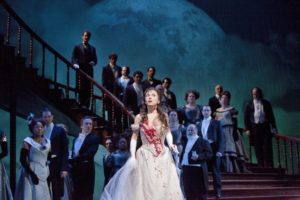
March Madness Part 1: The Top Five Mad Scenes In Opera
By Francisco SalazarIt’s officially the month of March Madness and to celebrate the month which will see “Elektra” and “Lucia di Lammermoor” open at the Metropolitan Opera, OperaWire will be writing a weekly article on our favorite mad scenes, favorite interpretations of mad scenes and some of the most iconic performances of mad scenes.
Lucia di Lammermoor-“Il Dolce Suono”
Donizetti’s mad scene in “Lucia” is considered the greatest written in the operatic canon and there are reasons for this. This three-part scene experimented with the form of aria-cavatina as well as the instrumentation, including the glass harmonica to give the scene a haunting sound and feel. The change in moods from calm and meditative to explosive also shape the psyche of Lucia and her inner turmoil. And while it gives plenty of chance for the soprano to show her virtuosic abilities, it is the power of the music that ultimately drives the scene. The final cavatina “Spari d’amaro” is not your typical upbeat fast section. Instead, it has an ethereal and otherworldly feel accompanied by the flute and glass harmonica.
Here is a performance of the mad scene by Joan Sutherland who mastered “Lucia di Lammermoor” with some of the greatest vocal technique in opera history.
Idomeneo-D’oreste, d’Aiace
From the beginning of the opera, Elettra is on edge and towards the end when she is thwarted in both her love and her ambition, the character vents her feelings in what might be the most electrifying moment of the entire opera. Unlike many of Mozart’s orchestrations, which are light and filled with joyous melodies, this one is dark and tempestuous, perfectly describing Elettra’s torment and pain. The vocal writing features complex coloratura and needs a powerful voice that can sing over the heaviness of the orchestration.
Here is a concert performance of the aria by Anna Netrebko who never performed the role but was highly lauded for her Mozart interpretations.
Hamlet- ‘A vos jeux’
Thomas’ opera can be considered by some dull and overly long. The work does lack melodic flow but what the composer did do so perfectly is exhibit a knack for drama. While Thomas’ mad scene features a number of challenging coloratura roulades for high sopranos, it is more of a somber display of drama. Throughout the 20-minute scene, the melodies change various times, the tempi fluctuate and there is a lot of recitative type singing that requires a strong actress to get the best out of the text. In all, there is a schizophrenic feel to the entire scene as we see Ophelie in sorrow and toward her imminent death.
Here is Natalie Dessay singing one of her signature roles in one of her greatest performances.
I Puritani- Qui la Voce
Can we call Elvira’s extended scene a mad scene or is it just the outbursts of a highly manic depressive? It’s hard to classify because Elvira’s madness is displayed throughout the work and even then one can see it more of a depressive young girl. This scene, while not as extreme as the three previously mentioned on this list, showcases Bellini’s hypnotic melodies and his impressive vocal writing. The musical sequence has become signature for most lyric sopranos and because the libretto is so questionable, it allows a soprano to interpret it in many diverse ways.
Here Diana Damrau brings her signature spontaneity, making for an unpredictable Elvira.
Otello – Act three finale
Otello begins as this heroic figure entering with command and poise. Verdi gives him a noble entrance and his subsequent Act one duet is filled with gorgeous lyric lines. But as the character becomes unhinged, so does his music. And nothing shows more lack of control than the end of Act three. His music imbues torment and a lack of control or power. Verdi’s orchestral writing is filled with stormy lines and Otello’s former legato lines turn to more staccato and disconnected phrasings. The heroic character is gone and is overpowered by Iago. And while this scene is less than a minute, Verdi is able to showcase the downfall and madness of Otello.
While these five moments in opera represent some of the greatest mad scenes, we can’t forget those of “Anna Bolena” and “Roberto Devereux” which showcase the downfall of two powerful queens, the madness of Imogene in “Il Pirata,” the sleepwalking scene in “La Sonnambula,” which recently has been portrayed with some delusional qualities, “Linda di Chamonix’s” second act aria or Margueritte’s Act four church scene or Act five in the clinic in “Faust.” And one could also talk about Antonia’s Trio at the end her act in “Les Contes d’Hoffmann” and of course the entire works of “Salome” and “Elektra,” which showcase two of Strauss’ most extreme and demented heroines.
What is your favorite mad scene and which did we miss?
Categories
Special Features

